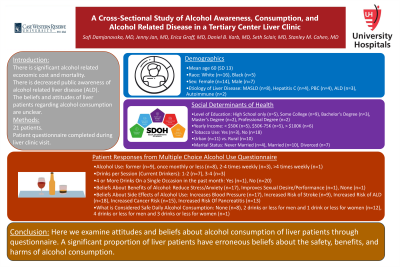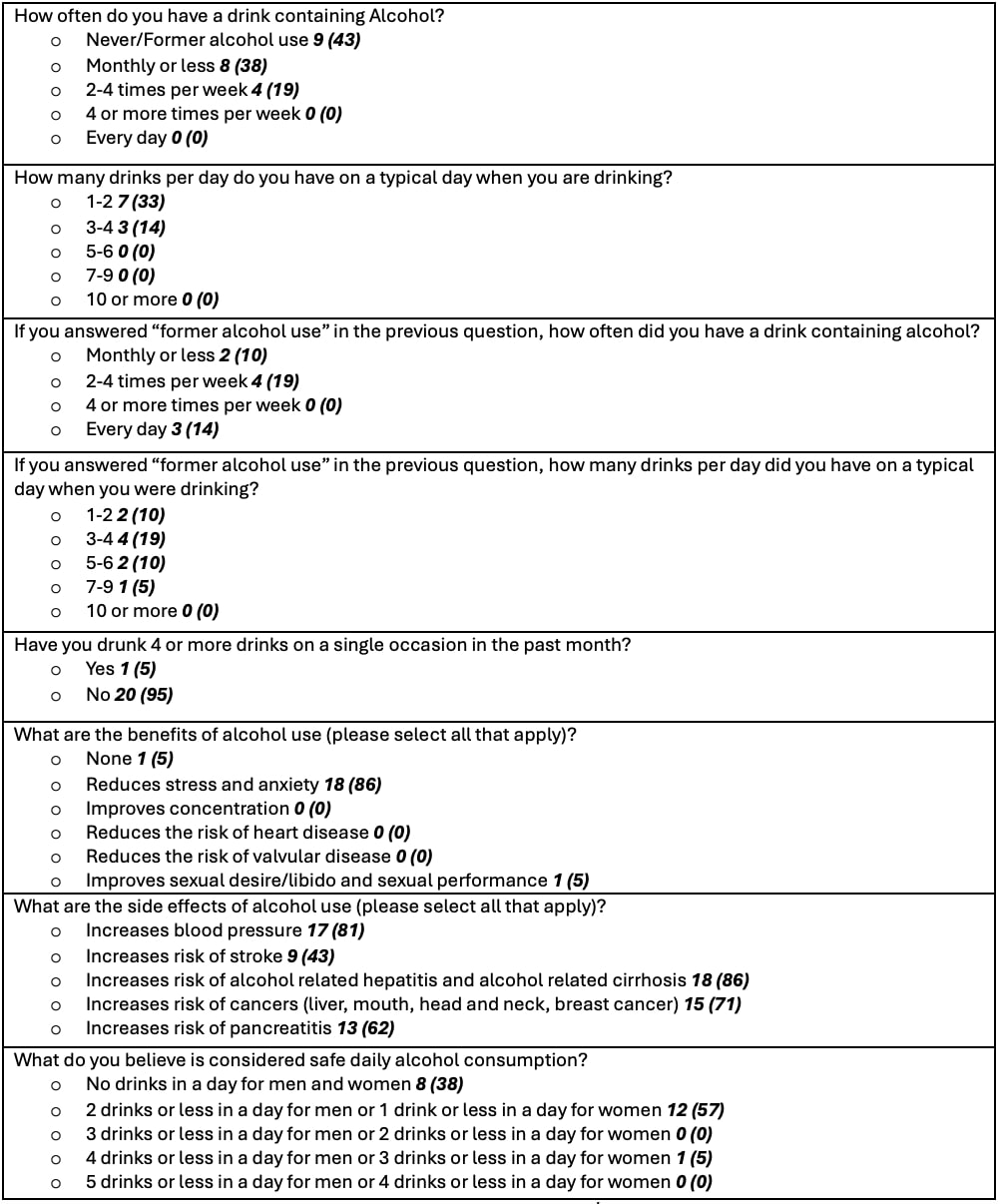Monday Poster Session
Category: Liver
P2895 - A Cross-Sectional Study of Alcohol Awareness, Consumption Patterns, and Alcohol Related Disease in a Tertiary Center Liver Clinic
Monday, October 28, 2024
10:30 AM - 4:00 PM ET
Location: Exhibit Hall E

Has Audio

Sofi Damjanovska, MD
University Hospitals Cleveland Medical Center, Case Western Reserve University
Cleveland, OH
Presenting Author(s)
Sofi Damjanovska, MD1, Jenny Jan, MD2, Erica Graff, MD1, Daniel Karb, MD3, Seth Sclair, MD1, Stanley M. Cohen, MD1
1University Hospitals Cleveland Medical Center, Case Western Reserve University, Cleveland, OH; 2University Hospitals Cleveland Medical Center, Cleveland, OH; 3Cleveland Clinic, Cleveland Heights, OH
Introduction: In the past decade in the United States there has been increase in alcohol related economic cost and mortality. We aim to identify alcohol awareness and consumption patterns in patients in liver clinics. Our hypothesis is that patients that lack knowledge of alcohol related complications will consume more alcohol and have alcohol related liver disease (ALD) as etiology of their chronic liver disease more often.
Methods: Twenty-one patients completed a multiple-choice questionnaire during their liver clinic visit. The questions pertain to alcohol intake, benefits and side effects of alcohol use.
Results: The mean age was 60 years with standard deviation of 13 years. Most patients (n=16 [76%]) were White and female (n=14 [67%]). Etiology of liver disease included metabolic dysfunction-associated steatotic liver disease (38%), hepatitis C (19%), primary biliary cholangitis (19%), ALD (14%), and autoimmune/cryptogenic (10%). Five patients (24%) had decompensated cirrhosis. 9 (43%) were former alcohol users, and 12 (57%) reported current alcohol use. All current alcohol users reported drinking 2-4 times weekly or less. Most current alcohol users reported 1-2 drinks (33%) or 3-4 drinks per sitting (14%). Former alcohol users were more likely to report daily alcohol use (14%) and binge drinking (15%). 86% of respondents believed that alcohol improves stress and anxiety. Most respondents identified an association between alcohol and negative health consequences. Most respondents correctly identified recommended targets for daily alcohol use. A single respondent believed that 4 drinks per day for men and 3 drinks for women was safe. A single respondent reported consuming > 4 drinks in a single sitting during the preceding month. Both of these individuals had ALD.
Discussion: Here we use a questionnaire to identify consumption patterns and beliefs regarding alcohol consumption in patients seen in liver clinic. Contrary to our hypothesis, most patients correctly identified harms associated with alcohol use. However, most also believed that anxiety reduction is a major benefit of alcohol use. Of the 2 respondents reporting recent binge drinking and markedly erroneous beliefs about appropriate alcohol consumption, both had ALD. Although the overall number of patients is modest, these data suggest high-yield areas for allocation of resources including alcohol use education to combat the widespread belief that alcohol positively affects anxiety and targeted alcohol use education for those with ALD.

Note: The table for this abstract can be viewed in the ePoster Gallery section of the ACG 2024 ePoster Site or in The American Journal of Gastroenterology's abstract supplement issue, both of which will be available starting October 27, 2024.
Disclosures:
Sofi Damjanovska, MD1, Jenny Jan, MD2, Erica Graff, MD1, Daniel Karb, MD3, Seth Sclair, MD1, Stanley M. Cohen, MD1. P2895 - A Cross-Sectional Study of Alcohol Awareness, Consumption Patterns, and Alcohol Related Disease in a Tertiary Center Liver Clinic, ACG 2024 Annual Scientific Meeting Abstracts. Philadelphia, PA: American College of Gastroenterology.
1University Hospitals Cleveland Medical Center, Case Western Reserve University, Cleveland, OH; 2University Hospitals Cleveland Medical Center, Cleveland, OH; 3Cleveland Clinic, Cleveland Heights, OH
Introduction: In the past decade in the United States there has been increase in alcohol related economic cost and mortality. We aim to identify alcohol awareness and consumption patterns in patients in liver clinics. Our hypothesis is that patients that lack knowledge of alcohol related complications will consume more alcohol and have alcohol related liver disease (ALD) as etiology of their chronic liver disease more often.
Methods: Twenty-one patients completed a multiple-choice questionnaire during their liver clinic visit. The questions pertain to alcohol intake, benefits and side effects of alcohol use.
Results: The mean age was 60 years with standard deviation of 13 years. Most patients (n=16 [76%]) were White and female (n=14 [67%]). Etiology of liver disease included metabolic dysfunction-associated steatotic liver disease (38%), hepatitis C (19%), primary biliary cholangitis (19%), ALD (14%), and autoimmune/cryptogenic (10%). Five patients (24%) had decompensated cirrhosis. 9 (43%) were former alcohol users, and 12 (57%) reported current alcohol use. All current alcohol users reported drinking 2-4 times weekly or less. Most current alcohol users reported 1-2 drinks (33%) or 3-4 drinks per sitting (14%). Former alcohol users were more likely to report daily alcohol use (14%) and binge drinking (15%). 86% of respondents believed that alcohol improves stress and anxiety. Most respondents identified an association between alcohol and negative health consequences. Most respondents correctly identified recommended targets for daily alcohol use. A single respondent believed that 4 drinks per day for men and 3 drinks for women was safe. A single respondent reported consuming > 4 drinks in a single sitting during the preceding month. Both of these individuals had ALD.
Discussion: Here we use a questionnaire to identify consumption patterns and beliefs regarding alcohol consumption in patients seen in liver clinic. Contrary to our hypothesis, most patients correctly identified harms associated with alcohol use. However, most also believed that anxiety reduction is a major benefit of alcohol use. Of the 2 respondents reporting recent binge drinking and markedly erroneous beliefs about appropriate alcohol consumption, both had ALD. Although the overall number of patients is modest, these data suggest high-yield areas for allocation of resources including alcohol use education to combat the widespread belief that alcohol positively affects anxiety and targeted alcohol use education for those with ALD.

Figure: Table 1. Alcohol Use Questionnaire with Responses n (%)
Note: The table for this abstract can be viewed in the ePoster Gallery section of the ACG 2024 ePoster Site or in The American Journal of Gastroenterology's abstract supplement issue, both of which will be available starting October 27, 2024.
Disclosures:
Sofi Damjanovska indicated no relevant financial relationships.
Jenny Jan indicated no relevant financial relationships.
Erica Graff indicated no relevant financial relationships.
Daniel Karb indicated no relevant financial relationships.
Seth Sclair indicated no relevant financial relationships.
Stanley Cohen indicated no relevant financial relationships.
Sofi Damjanovska, MD1, Jenny Jan, MD2, Erica Graff, MD1, Daniel Karb, MD3, Seth Sclair, MD1, Stanley M. Cohen, MD1. P2895 - A Cross-Sectional Study of Alcohol Awareness, Consumption Patterns, and Alcohol Related Disease in a Tertiary Center Liver Clinic, ACG 2024 Annual Scientific Meeting Abstracts. Philadelphia, PA: American College of Gastroenterology.
